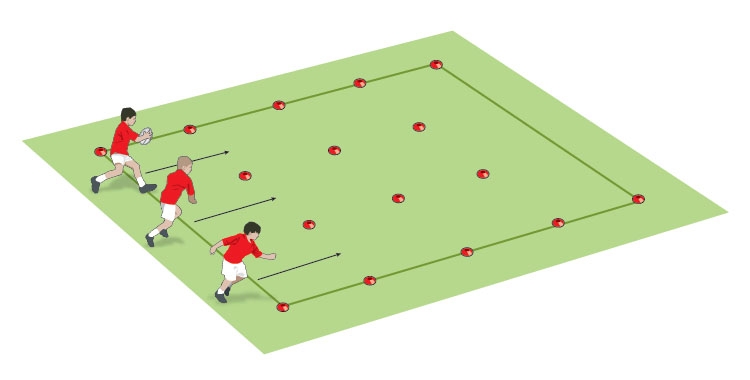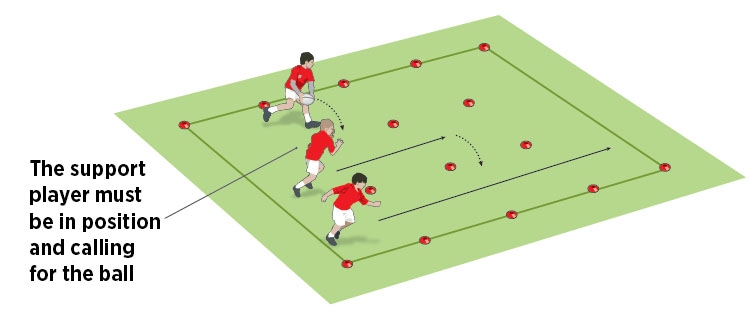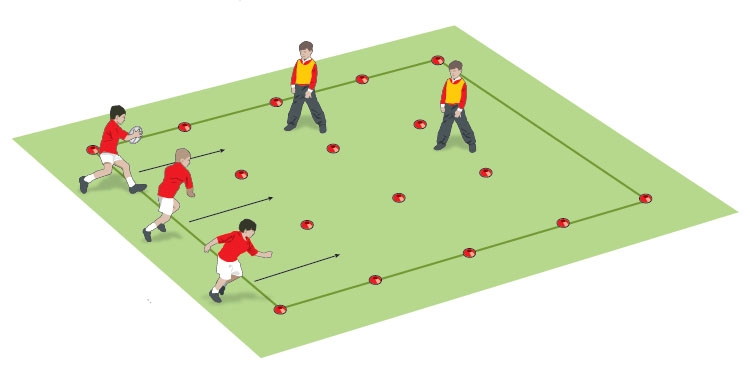You are viewing
1 of your 2 free articles
Passing pace
Passing and Handlingby Dan Cottrell
U9 | HANDLING 6
Encourage accurate passing and communication when running in support




Run another game alongside.
“Pass softly, but with the hands following through to the potential target”
“Run straight and call for the ball”
“Put your hands out towards the pass”
Encourage accurate passing and communication when running in support
- Set out a 10m x 6m area with sets of three 2m cone gates at 3m, 5m and 7m. Put three attackers along one side of the area with the cone gates in front of them. Give a ball to a player at one end.
- When you say “go”, the players run forward. At all times, the ball carrier can only look forward, not to his side.


- When the ball carrier reaches the first gate, the second player in the line gives him a call to pass. Because he is looking forward, the ball carrier is forced to pass across his body, with hands following through to the target.
- Because players can only look forward, it’s inevitable that the ball will be dropped, but this is part of the process of learning to pass the ball across the body.

- The second player continues running to the next gate and passes to the third player who calls for the ball. All players race through to the line, turn and repeat.
- Make the game more challenging by putting two defenders to act as targets to fix before passing. Start them just standing, but if players progress well, make them come forward to put pressure on the ball attackers.

You will need
- A 10m x 6m
- 1 ball
- Cones
- Bibs (optional)
Got more players?
Run another game alongside.
What to tell your players
“Pass softly, but with the hands following through to the potential target”
“Run straight and call for the ball”
“Put your hands out towards the pass”
Newsletter Sign Up
Coaches Testimonials

Gerald Kearney, Downtown Las Vegas Soccer Club

Paul Butler, Florida, USA

Rick Shields, Springboro, USA

Tony Green, Pierrefonds Titans, Quebec, Canada
Subscribe Today
Be a more effective, more successful rugby coach
In a recent survey 89% of subscribers said Rugby Coach Weekly makes them more confident, 91% said Rugby Coach Weekly makes them a more effective coach and 93% said Rugby Coach Weekly makes them more inspired.
Get Weekly Inspiration
All the latest techniques and approaches
Rugby Coach Weekly offers proven and easy to use rugby drills, coaching sessions, practice plans, small-sided games, warm-ups, training tips and advice.
We've been at the cutting edge of rugby coaching since we launched in 2005, creating resources for the grassroots youth coach, following best practice from around the world and insights from the professional game.
More from us
© 2023 Rugby Coach Weekly
Part of Green Star Media Ltd. Company number: 3008779
We use cookies so we can provide you with the best online experience. By continuing to browse this site you are agreeing to our use of cookies. Click on the banner to find out more.













